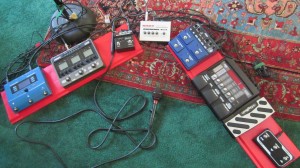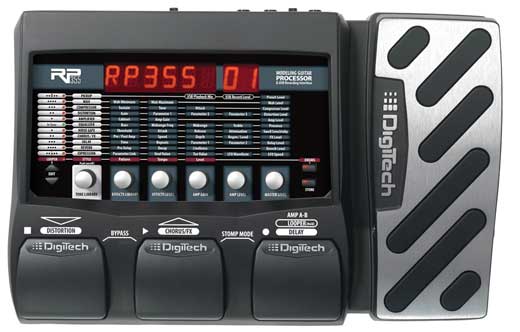There was a recent discussion on Harp-L of FX, which I found revealing of all sorts of things. It’s chronicled here, and be warned: gotta lotta words. (The boldface emphases I put on certain lines in that discussion were added by me, and were not present in the initial conversation. However, I thought it a good idea to break up all that text once in a while, and highlighting some of the big messages seems like a good way to do it.)
I started it out with this:
One thing I know for sure: whenever anybody says “FX do some very cool things,” a lot of people can be counted on to say “I sound just fine without ‘em.”
To me that’s missing the point. Of course harp without FX sounds fine. (See the widget for my solo CDs at the end of this post.) So does guitar. And keys. And all the other instruments where the players are lots more adventurous with their sounds than harp players. And getting a lot more work, too, as a rule.
Clarinet without FX sounds fine, too. At one time it was a very prominent instrument in the popular music of its day–that is, the 1930s-40s. The records made in those days still sound great, but they don’t sound much like what the public is paying to listen to now. I can’t recall the last time I heard a band in any–I repeat, any–style featuring clarinet. Why not? It still sounds fine. But it doesn’t sound like now.
I would prefer not to see the instrument I have loved for close to 50 years go the way of the clarinet. To that end, I intend to keep pushing the boundaries of the instrument itself and the gear I use to make it loud and proud. I won’t accept limits on the sounds I can make with a harmonica, anymore than I would with any other instrument. If I need to add something to the sound to make it bigger/wider/wilder/wierder, I will. If I played the clarinet, I’d damn sure be running that through a pitch shifter, a delay, and a wah-wah too, not because clarinet doesn’t sound good, but because I have no intention of getting left behind while everyone else in the world gets to make the sounds of modern music.
Of course, some people just don’t much like modern music. There’s no argument there; what you like is what you like. But I’d rather try to redefine it on my terms than pretend it’s not there.
FYI, I played today to an audience in Sao Paolo, Brazil, with chromatic jazz harmonica virtuoso Wim Dijkgraaf. Both of us played acoustic harp–me a Lee Oskar Natural Minor, Wim a Hohner CX12–through the same mic on “Comin’ Home Baby.” It was great; I’ll see about posting my recording of it to my website later this week. (Note Nov. 1 2014: the recording is now available here.) That said, Wim told me he picked up a Digitech RP355, and I’m sending him my patchset right after I write this message. He doesn’t need an RP to sound good. He wants an RP so he can sound different when he wants to. Is that a problem? Not for me.
I got a number of replies to this post, some pointing out that clarinet players are actually very prominent in certain bands, many of them playing in Europe, most of them playing in various traditional (usually acoustic) styles. Thanks all for bringing that to my attention.
What? There’s More?
Then Rick Davis, who promotes Mission Harp Amps from the store on his site and makes and sells a small harp amp based on a Mission design–who obviously has a dog in this hunt–came in with this one:
> So, you want to save the harmonica by making it sound like a clarinet? Or
> a trumpet? Or a Hammond B3? I’m not sure that is a good plan, or even a
> necessary one.
>
> When you use processors or effects to make a harp sound like a trumpet, for
> example, it doesn’t work. It does not sound like a trumpet; its sounds
> like what it is: A processed harmonica. It is usually not a sound I like.
> it sounds flanged and phased and EQ’d and compressed and octaved and
> filtered. If it is well played I will admire the musicianship in spite of
> the sound, but I can’t help but ask myself “Why?”
I suppose that if I was the owner of a shop that makes traditional tube harp amps that cost, at the low end, about 2-3 times what it costs to buy an RP360XP plus my patchset, and more than an RP360XP and a Peavey KB2 keyboard amp plus my patch set combined, I might have doubts about less-expensive but much-more-powerful alternatives to traditional amps too.
Anyway, here’s my reply to Rick and the list:
First, I have no illusions that I’m going to “save the harmonica.” I’m trying to make the world occupied by harmonica players a better place than it was when I found it, “better” meaning that harmonica players have more extensive technical, conceptual, and sound-shaping tools and skills when I go than when I arrived, and more cool stuff to listen to.
Second, the point above is an obvious distortion of my comments. Nowhere did I say that the goal was to make the harmonica sound like a trumpet, or a clarinet, or a B3. I used the clarinet as an example of an instrument whose time has largely come and gone, to which other list members responded with examples of current bands using it. That settled, the point is to be able to extend the range of sounds available to the instrument. By the way, if you read this list regularly, you know that the ability to emulate a B3–or more specifically, the rotating speaker (Leslie) sound that we all associate with a B3–is something desired strongly by many members of this list; the rotary speaker patches I put together are probably the most popular in my patch sets after the basic amped-up stuff.
Writing off electronics for the harmonica is in effect writing off everything that electric guitarists have had more or less to themselves for the last (nearly) 50 years. The point isn’t to sound like Jimi Hendrix, the point is to be able to make good use of the tools available to us. in any case, Jimi Hendrix didn’t attempt to sound like a trumpet or a clarinet. He wanted to sound different from anything anybody had ever heard. So do I.
The comment that
>A processed harmonica… is usually not a sound I like.
> it sounds flanged and phased and EQ’d and compressed and octaved and
> filtered.
is unintentionally ironic. If you run a microphone into a tube amp, you’re using a processor, because the tube amp itself is a signal processor by definition. You’re certainly compressing the signal, because tube amps add compression by design, usually increasing as gain and/or volume is cranked up. Almost every harp player I know that relies on a tube amp uses the onboard EQ–usually low, mid, and high, in order of decreasing emphasis in the EQ–heavily. (In other words, a harp run through a tube amp is a “processed harmonica.”) That leaves flanging, phasing, octaving, and filtering (which typically means either an auto-wah or a wah-wah, unless you meant additional EQ, because of course EQ is a type of filter).
In other words, you dislike all the “new” stuff–the sounds that became prominent in rock, pop, electronica, etc. starting in the 1980s, i.e. about 35 years ago. I could just as easily argue that “acoustic” harp players have good reason to dislike tube amps, because they corrupt the pure sound of a harmonica. Which they surely do, but it’s a corruption we all like, isn’t it? Human ears like distortion. Human ears like lots of other stuff too.
About 35 years: that’s how long it’s been since many players tried anything fundamentally new in their rigs. Meanwhile, the evolving musical landscape is going steadily more electronic, which is fine for harp players, because we can use those tools too.
Also by the way, you make and sell traditional-style harp amps, the Mission amps, right? I suppose that business reflects your taste in harp sounds, which of course is all to the good. We’ll see which view prevails. I’m pretty sure that history is going my way.
Wrapping it up
I made a mistake in my post, of course; Rick doesn’t own Mission Harp Amps; he manufactures and sells an amp based on one of their designs. My apologies for the inaccuracy. No apologies for the attitude.
Want to check out the sounds that are causing all the controversy? You can access plenty of samples of the sounds in my patch set for Digitech RP here.
And just in case anyone doubts that I know how to play a harmonica without a signal processor between me and the audience, just check out my solo harmonica CDs at CDBaby. I don’t have to use FX to make music; I just like to.











